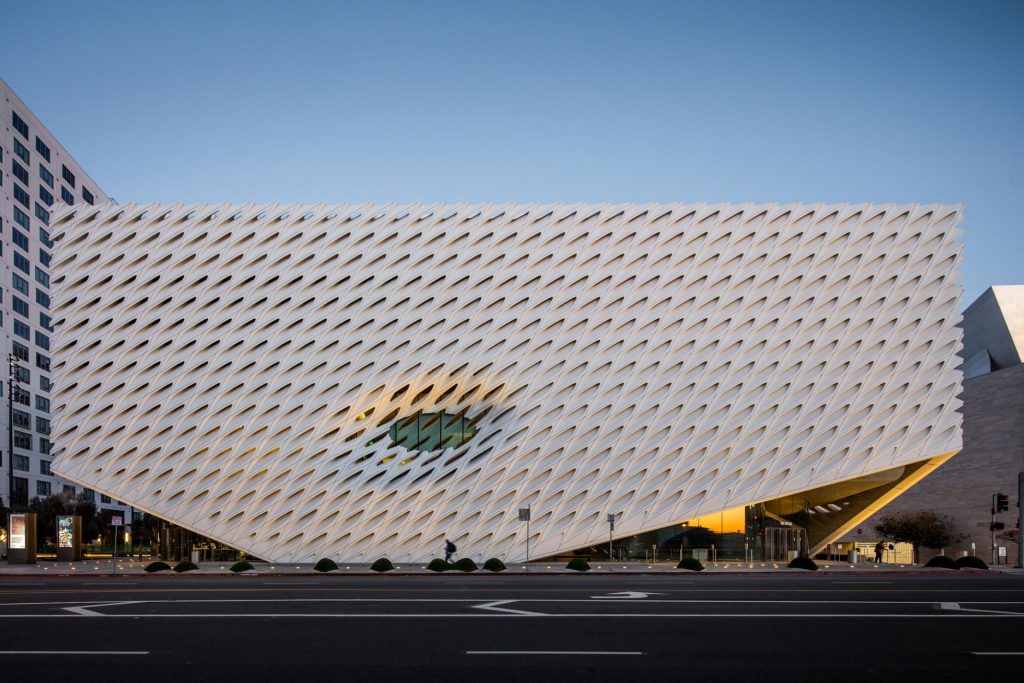This weekend the Broad Museum in Los Angeles celebrates its tenth anniversary. The Museum, which currently is exhibiting Jeffrey Gibson: The space in which to place me,” has succeeded in ways one could only have hoped for at their launch.
Over the last decade, The Broad has become a destination. Attendance has exceeded all initial projections (an estimated 6.7 million admissions). It is where I reliably send visitors to LA. The distinctive Diller Scofidio + Renfro honeycomb facade, dubbed “The Veil” had come to be a landmark. The museum has launched millions of Instagram-worthy selfies taken in the Yayoi Kusama Infinity Room, in front of Jeff Koons’ balloon dog, or next to Robert Therrien’s giant chair and table, a 1994 work called “Under The Table.”
There have been memorable well curated exhibitions initiated by the Broad and several which have traveled to the Broad, including a William Kentridge exhibition, as well as wonderful exhibitions of the works of Mickalene Thomas, Keith Haring, Cindy Sherman, Takashi Murakami, and Jeffrey Gibson (currently on display).
Although Eli Broad’s original vision of Grand Street becoming a cultural hub and economic driver for Downtown LA has not fully happened (yet!), it is closer to becoming one that it was a decade ago. The Broad does complement Disney Hall and makes that side of Grand Street tourist and visitor filled. The other side of Grand Street has the Museum of Contemporary Art (MOCA), the completed expanded Colburn Music School, The Conrad Hotel, and the other Gehry designed buildings in the Grand Street complex. However, Grand Street remains a work-in-progress in terms of igniting the surrounding downtown neighborhood. And it remains and feels totally separate from the Music Center across the street where The Ahmanson and Mark Taper reside in its Lincoln-Center-like Plaza.
When the Broad opened, I was clear about what I thought were the museum’s strength and weaknesses. I described the collection as one that would give any visitor pleasure with its greatest hits collection of Art of the second half of the twentieth century, featuring great paintings by Warhol, Jasper Johns, Basquiat, to name but a few.
Although the museum was the collection of one wealthy individual, Eli Broad, the collection lacked the strong point of view you find in such eponymous museums as The Gardner, The Barnes, or The Frick. However, credit goes to Joanne Heyler, the founding director and president of The Broad. As the director and Chief Curator of the Broad Foundation, Heyler has not only shepherded the collection but guided the Museum in further acquisitions and particularly, since Eli Broad’s death in 2021, shown an adventurous and expansive vision for the Broad, staging and attracting important, great, and groundbreaking shows. Under Heyler’s leadership The Broad has become an important home for contemporary art and career-defining artist exhibitions. I also want to single out curator Ed Schad who often imbues the exhibitions and the attendant programs with art critical and intellectual heft leavening them with a healthy dose of fun.
At its opening, my objection to The Broad was that the Museum was more art storage than exhibition space. With 85% of the collection remaining in “The Vault,” there was too little of the collection on display. Also, although admission was free, there was a hefty parking charge, and the museum did occasionally charge for special exhibits.
Some of that is being addressed: The Broad is building a 55,000 square foot addition slated to open before the 2028 Olympics that will double the museum’s exhibition space. I am not going to claim credit for the expansion, but I am glad they are doing so. Now as to my other two concerns – I hope that the Broad finds a benefactor to make the first two hours of parking at the Broad free (probably won’t happen but one can always hope); and although the extra special exhibition fees seem to happen less often lately, I hope there is a way for those fees to not happen at all. I still remember being at the museum’s opening when Eli Broad declared the museum to be his “gift to the city” and that admission would be free.
Now, if anyone is listening, I do have one other suggestion, or prediction: MOCA should come under the umbrella of The Broad.
Despite having an outstanding permanent collection, MOCA has never been on the solid financial footing it needs or had the sustained leadership and funds to fulfill its potential despite some memorable art historical exhibitions particularly in the Paul Schimmel era. Whether this means a merger, a takeover, or just a management collaboration agreement –I’ll leave that to the lawyers. The two museums are across the street from each other – and a healthier MOCA would be good not just for The Broad, but for Grand Street, Downtown LA, and for all of Los Angeles. I hope it happens. And before the Broad’s 20th anniversary.
That’s for the future. In the present, let’s celebrate a decade of The Broad and how much pleasure it has given to millions and millions of visitors – including me!

